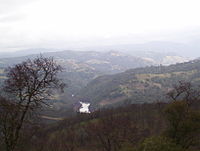
Back مقاطعة كالافيراس (كاليفورنيا) Arabic Kalaveras qraflığı (Kaliforniya) Azerbaijani Calaveras County, Kalifornien BAR Калаверас Bulgarian ক্লাবেরাস কাউন্টি, ক্যালিফোর্নিয়া BPY Калаверас (гуо, Калифорни) CE Calaveras County CEB ناوچەی کالاڤێراس (کالیفۆرنیا) CKB Calaveras County Czech Calaveras County, Califfornia Welsh
Calaveras County, California | |
|---|---|
 Calaveras County view | |
 Interactive map of Calaveras County | |
 Location in the state of California | |
| Country | United States |
| State | California |
| Regions | Sierra Nevada, Gold Country |
| Incorporated | February 18, 1850[1] |
| Named for | Spanish word meaning "skulls" |
| County seat | San Andreas |
| Largest community | Rancho Calaveras (population) Mountain Ranch (area) |
| Government | |
| • Type | Council–CAO |
| • Body | Board of Supervisors[2] |
| • Chair | Martin Huberty |
| • Vice Chair | Benjamin Stopper |
| • Board of Supervisors[2] | Supervisors
|
| • County Administrative Officer[3] | Crista Voh Latta |
| Area | |
• Total | 1,037 sq mi (2,690 km2) |
| • Land | 1,020 sq mi (2,600 km2) |
| • Water | 17 sq mi (40 km2) |
| Highest elevation | 8,174 ft (2,491 m) |
| Population (2020) | |
• Total | 45,292 |
| • Density | 44/sq mi (17/km2) |
| GDP | |
| • Total | $1.642 billion (2022) |
| Time zone | UTC−08:00 (Pacific Time Zone) |
| • Summer (DST) | UTC−07:00 (Pacific Daylight Time) |
| Area code | 209 |
| FIPS code | 06-009 |
| GNIS feature ID | 1675885 |
| Congressional district | 5th |
| Website | calaverasgov |
Calaveras County (/ˌkæləˈvɛrəs/ ⓘ), officially the County of Calaveras, is a county in both the Gold Country and High Sierra regions of the U.S. state of California. As of the 2020 census, the population was 45,292.[6] The county seat is San Andreas.[7] Angels Camp is the county's only incorporated city. Calaveras is Spanish for "skulls"; the county was reportedly named for the remains of Native Americans discovered by the Spanish explorer Captain Gabriel Moraga.
Calaveras Big Trees State Park, a preserve of giant sequoia trees, is in the county several miles east of the town of Arnold on State Highway 4. Credit for the discovery of giant sequoias there is given to Augustus T. Dowd, a trapper who made the discovery in 1852 while tracking a bear. When the bark from the "Discovery Tree" was removed and taken on tour around the world, the trees became a worldwide sensation and one of the county's first tourist attractions. The uncommon gold telluride mineral calaverite was discovered in the county in 1861 and is named for it.
Mark Twain set his story "The Celebrated Jumping Frog of Calaveras County" in the county. The county hosts an annual fair and Jumping Frog Jubilee, featuring a frog-jumping contest, to celebrate the association with Twain's story. Each year's winner is commemorated with a brass plaque mounted in the sidewalk of downtown Historic Angels Camp and this feature is known as the Frog Hop of Fame. Lukas Foss used Twain's story for his 1950 opera The Jumping Frog of Calaveras County.
In 2015, Calaveras County had the highest rate of suicide deaths in the United States, with 49.1 per 100,000 people.[8]
- ^ "Chronology". California State Association of Counties. Archived from the original on January 29, 2016. Retrieved February 6, 2015.
- ^ a b "Supervisors".
- ^ "Solano County – County Administrator".
- ^ Corral Ridge
- ^ "Gross Domestic Product: All Industries in Calaveras County, CA". Federal Reserve Economic Data. Federal Reserve Bank of St. Louis.
- ^ "Calaveras County, California". United States Census Bureau. Retrieved January 30, 2022.
- ^ "Find a County". National Association of Counties. Archived from the original on May 31, 2011. Retrieved June 7, 2011.
- ^ "Underlying Cause of Death, 1999–2015 Results". Centers for Disease Control and Prevention. Retrieved January 11, 2017.

